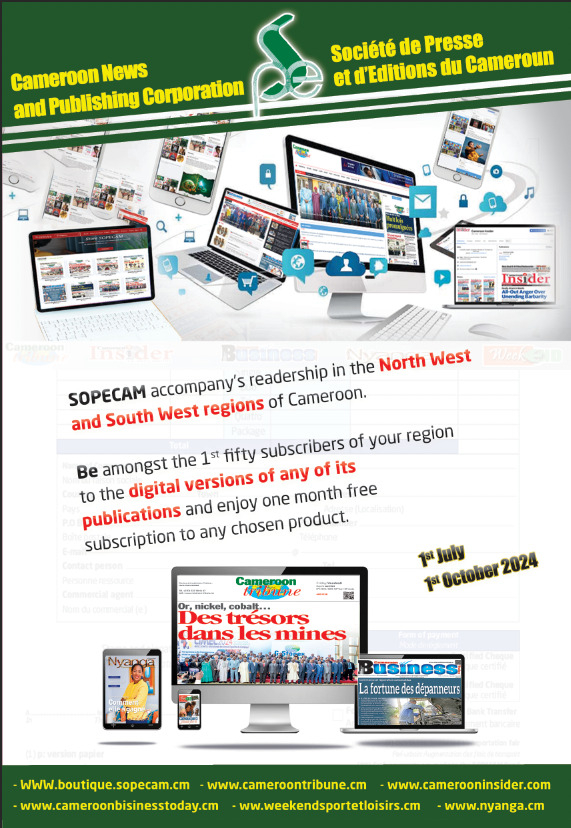Growth-induced Sectors : Rethinking Funding Approach
- Par Godlove BAINKONG
- 20 oct. 2022 10:56
- 0 Likes
Every individual, organisation or country logically has ambitions to be better tomorrow than today. Some would call it vision while others would qualify it as ambition. Whatever name one choses to give to the drive, the bottom line is that the dreamer or vision bearer almost always strives to put in efforts to attain set objectives. While individuals would work to step up their incomes and standards of living, governments would have a broader prospect of developing those sectors that have the tendency to power the economy to boom, therefore improving upon the living conditions of the governed.
Those who are meticulous would set timeframes for attaining their objectives; one after the other. This is to ensure that precious time and scarce resources are not wasted. Cameroon had already scanned her priority sectors which among others include agriculture, small and medium-sized enterprises, tourism and a lot more. What this entails is that efforts are supposed to be put in place to better develop the sectors that have shown their capability in job creation and could better lift wealth generation. This is strategic planning whose fruits are supposed to be visible in the quantity and quality of production in the concerned sectors.
As a developing country, Cameroon has made known her ambition of attaining a middle-income economy status by 2035. According to strategic planners working to realise the Head of State’s dream, this passes through structurally transforming the economy to make it production-based rather than depend on the outside world, sometimes to feed the citizens. This means that the country has to maximise her production potentials and step up local processing so as to considerably reduce imports, especially of what can be produced at home. This is why Import Substitution features in almost all public speeches now. While other countries with the same vision like Cameroon are opting for well-adapted funding mechanisms through which actors in the already identified sectors can get money to develop their projects and refund at fruition, what is visible here is rather the multiplicity of government-created, funded and run projects and programmes through which huge scarce resources are pumped in with mitigated results to show on the field. Some fast-growing developing economies in the world today have set up either specific banks or funding platforms for specific sectors. You will see bank for agriculture, bank for small and medium-sized industries, bank for tourism, bank for telecommunications and the list continues.
What is peculiar about this funding model is that once created and functional modalities outlined and endorsed, the body dishes out activity-enhancing loans to desired individuals or organisations based on their expressed request; motivated by their business plan and backed up by clear collateral for refund. These structures besides possessing the requisite funding for its sector equally has experts to coach debtors into taking one loan or the other. With such a setup, only matured projects are submitted for scrutiny by experts of a particular domain under clearly defined eligibility conditions. This option saves the individual or organisation from the ordeal of going through commercial banks to get sometimes ill-adapted loan, safeguards the State of shylock project owners who might crop up just to cash and carry away money even when they don’t have any serious project and as well reduces the State’s indebtedness in funding elephant projects or those with little development impact.
Like any human endeavour anyway, this funding mode certainly has its downside; but its merit to deal directly with actors who have shown proof of developing their activities, contribute to economic growth and refund the borrowed money for others to take and develop theirs is better. It also has the advantage to keep the economy buoyant without necessarily deepening government’s indebtedness. The least of its advantages is not even its ability to nip in the bud ungentlemanly behaviours like using government projects and programmes as political tools through which bootlickers are compensated and adversaries sanctioned.
Putting in place comprehensive and well-adapted funding mechanisms for the economy where accessibility is based solely and indiscriminately on the strength of the project requiring funding can better develop the private sector that is known all over the world to be driver of growth in terms of job creation and wealth generation. Cameroon’s private sector, like any other, is a catalyst or should be made as such in the country’s economic development, capable of providing goods and services, employment and other growth opportunities for citizens. Facilitating access to funding to expand their businesses could be a step in the right direction. The best way is putting in place well-adapted funding bodies wherein they can receive money and advice to develop their business so as to live and let live the economy and the population. Making conditions more favourable for the development of private agribusinesses and small bu...
Cet article complet est réservé aux abonnés
Déjà abonné ? Identifiez-vous >
Accédez en illimité à Cameroon Tribune Digital à partir de 26250 FCFA
Je M'abonne1 minute suffit pour vous abonner à Cameroon Tribune Digital !
- Votre numéro spécial cameroon-tribune en version numérique
- Des encarts
- Des appels d'offres exclusives
- D'avant-première (accès 24h avant la publication)
- Des éditions consultables sur tous supports (smartphone, tablettes, PC)













Commentaires